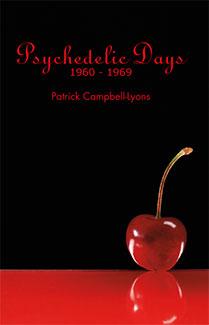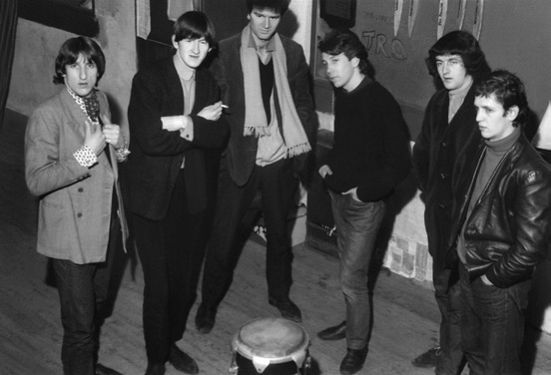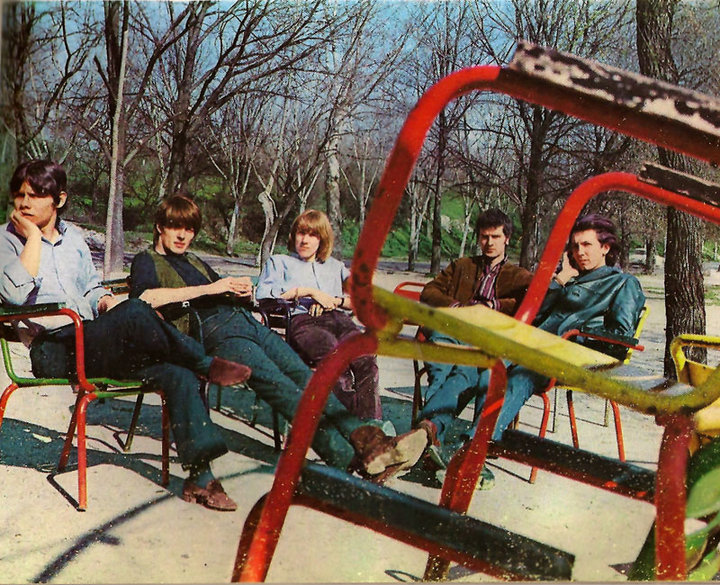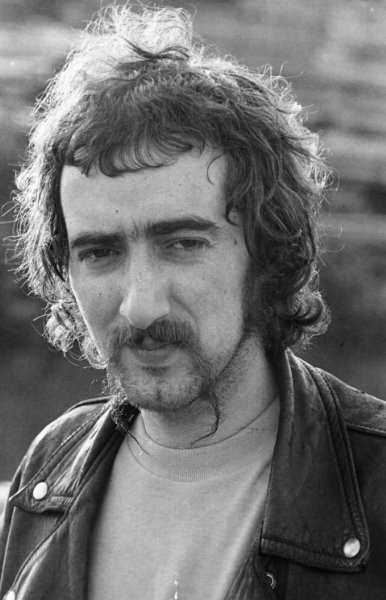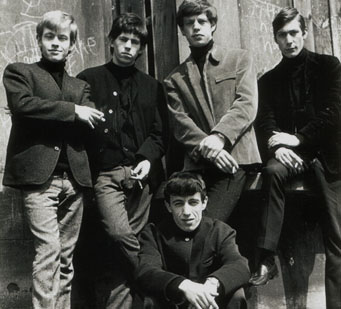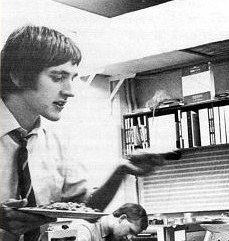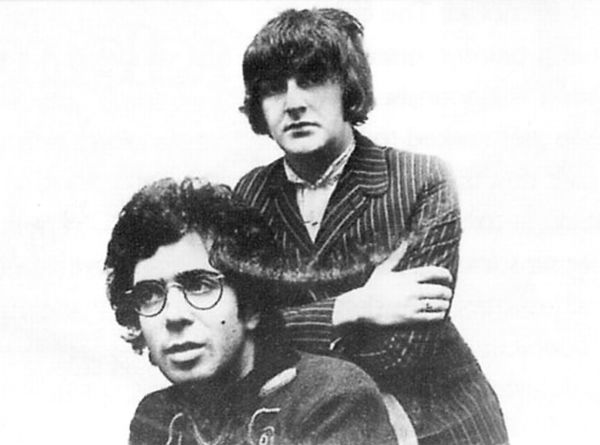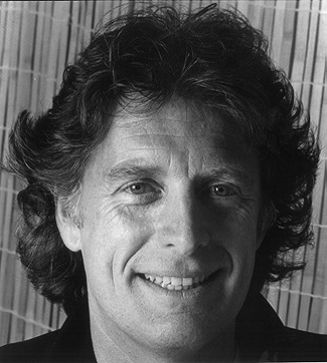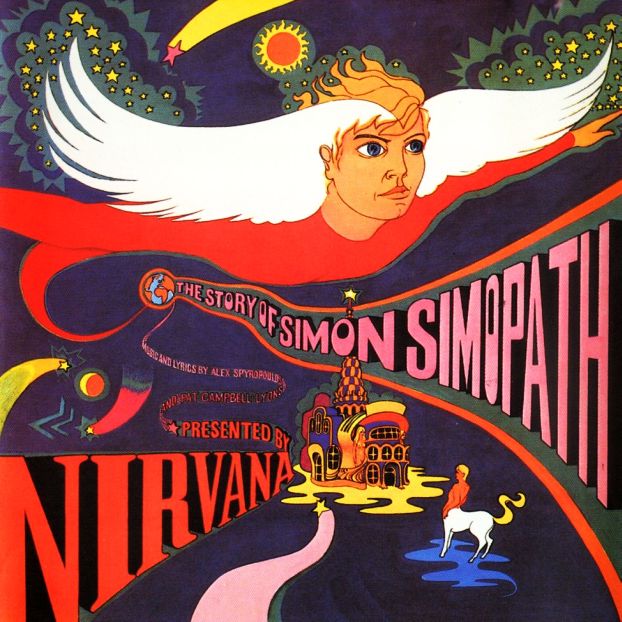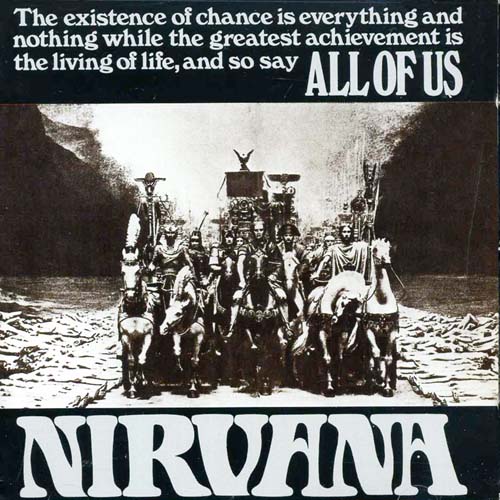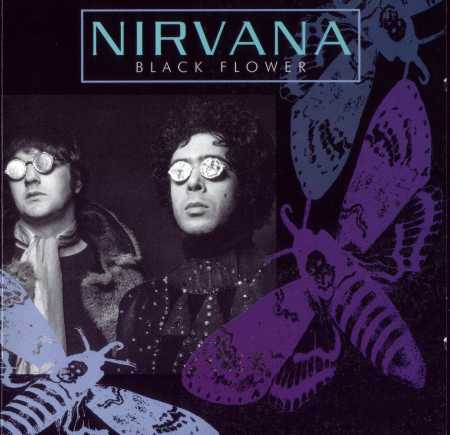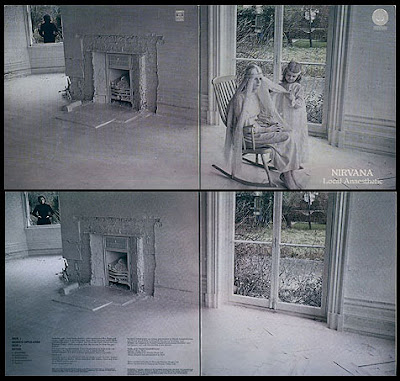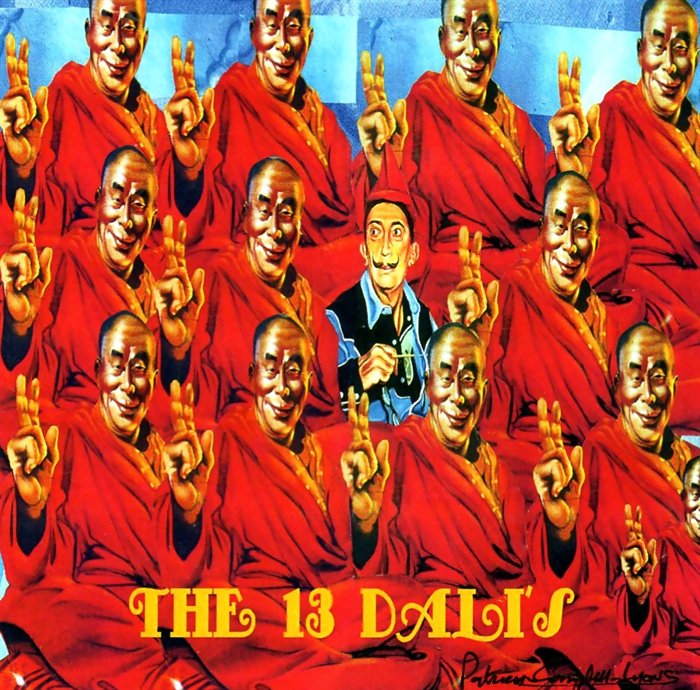Jason Barnard of the Strange Brew Podcast talks to Patrick Campbell-Lyons, one half of psychedelic pioneers Nirvana.
A legendary sixties figure, Patrick tells the Strange Brew of his early days to his time in Nirvana, the first group to be released on Island Records and the first to produce a rock-opera with “The Story of Simon Simopath” LP. They produced some truly magical material including the “Tiny Goddess” and “Pentecost Hotel” singles and a string of peerless albums including “All Of Us” and “Black Flower”.
Patrick has continued to produce a range of great material, and tells of his recent successful book Psychedelic Days. With a forthcoming Nirvana release and one of the hottest British bands sampling “Rainbow Chaser” it’s a great time to meet up.
In the British music scene of the late sixties, Nirvana are up there with any band. Your book Psychedelic Days is a great insight into those times.
Yes, it’s had some pretty good reviews and sales have been good. I’ve been on book reading tours, two in America and a couple in England. The reaction has been pretty fantastic, especially amongst younger people.
One of the most interesting aspects, compared to many of the artists I speak to, is that you’re from Ireland. What was like growing up in the 40s and 50s compared to the British post-war era which had rationing and then the growth of rock and roll.
Ireland wasn’t at war and in its treaty is governed by peace and rather than engagement. It was agricultural and still finding its feet after its own tragic history. If you lived in a small town you were controlled by the school and the church. They indoctrinated your family, you didn’t know any better. But it was good as you got an education. I remember so well, one of the most beautiful things you learnt at school was Latin. As the Christian brothers my teachers were sowing the seeds of vocation for the priesthood and if that failed there was a possible career in teaching or medicine if you had family connections.
You came to London when you were 18.
I came here to work in the summer holiday as a student and then got bitten by the bug.
Was that the music bug?
Well, it was everything. Finding a new freedom. Finding another life as a young man. It wasn’t so cloistered. In Ireland I’d heard music in our house. John McCormack and singers that my mother had got as 78s. There was an orchestra in our town. They’d play jazzy hits of the time.
Is that the showbands?
That was before then. They played more Glenn Miller type music- big bands. But they’d always play a few rock and roll things in the band. The showbands came in when I was 15-16. I was aware of them and heard American hits. I had a radio and could listen to Radio Luxembourg top twenty on a Sunday night. I knew a bit about Irish music. Going to family gatherings there was always someone who’d play the paino, recite, violin or accordian. I sang in choirs at the school. I had a funny little banjo thing that somebody in my family, an uncle, had made. But until I came to London I was not active in any form of the creative arts, I was a fully signed up “head in my books” student.
You had money from your job in an ice cream factory.
Every year Walls ice cream factory in Perivale, West London would take on 500 Irish students to work during the summer because ice cream was big business in the summer. I was saving up as the idea was to go back to Dublin and start my matriculation- first year entry into university. It was a standard thing, it went on for years. Some of us came back two or three times but I didn’t.
You then formed bands?
It was the whole atmosphere. West Ealing. The art school. Going out with girls for the first time and the music itself. I just found a new way of living.
Was that r’n’b?
The first band I had was only playing covers. There was two other Irish guys and we used to play weddings and pubs. I then formed a beat combo type band with a couple of English guys and the I formed an r’n’b group. I see on your Strange Brew site you have a thing on the Tomcats?
Yes, I did a feature on July, including Tom Newman.
They were around at the time in Ealing. First they called The Tomcats and then they became July. Two of the guys in the band, Tony Duig and Jon Field were with me in The Second Thoughts.
They went on to Jade Warrior.
Yes, very much later they signed to Island Records – the label we started with as Nirvana. So it’s kind of an interesting circle. Chris Thomas who was the bassist in The Second Thoughts went on to become a big producer who went onto remix the third Nirvana album.
The other interesting aspect of your life compared to other artists is that you were part of the sixties scene. You knew Pete Townshend, Speedy Keen, John McVie and Ronnie Wood.
It was a definitive scene. So many people came out of it. In those three bands that I knew in West Ealing. The Second Thoughts, The Krewsaders was Speedy’s band before he joined The Second Thoughts. The bass player in The Krewsaders was John McVie. They all lived in the same square mile between West Ealing, Hanwell and Ealing Broadway. A lot of musicians came into the area because of Jim Marshall’s music shop. There was Ealiing Jazz Club where the bands played.
Didn’t you share a bill with The Rolling Stones there?
Two, or three times. We were the number one band in Ealing and they were in the number one band in Richmond. Eventually they became the number one band everywhere!
You also went over to play The Star Club in Hamburg. Was that with The Second Thoughts?
Somebody offered us a contract after we played the 51 Club in Leicester Square with The Downliners Sect. Somebody came up and said “Would you like to go to Hamburg?”. Most of us said yes, a couple said no as wouldn’t leave their girlfriend and you could not could you. We got someone else. That was always the situation in those days- could you be in a band or with a girl. Some of the girlfriends didn’t like their boys going over.
One of your next projects was working with Chris Thomas as Hat and Tie. “Finding It Rough” is on loads of psychedelic compilations.
It has become a cult classic for a lot of people. This was before Nirvana started. It’s a far cry from the kind of music I started making later. It’s almost psych-rock I suppose. That was the direction we took. Throughout my life I’ve never really planned things. I’m a great believer in fate. I follow what’s put before me. I don’t just jump straight in but I’m guided by my muse a lot.
https://www.youtube.com/watch?v=255UvDvigso
After I got sick and got back after being in Stockholm I decided to back on the road again. Chris and I bought a couple of Revox tape recorders and we started writing a bit. That song came out of that. We got a songwriting deal on it, cut it as a single and down the line the Everly Brothers recorded it.
That must have been amazing.
When I think about now I think “Is that really true?”
Obviously Chris Thomas is renowned now for his production work. Was it his new role at Abbey Road with George Martin that made you go onto new projects.
No, he had applied when we were messing about and writing in Ealing. His mother was a music teacher, his father at the bank. They probably didn’t want him to go into the music business. He wrote a letter personally to George Martin at EMI saying he would be willing to work as a tea-boy assistant just to learn about production. He heard nothing back, not even a written reply. Then a year later just out of the blue, a letter came back saying “You remember you applied to us. Well could you be here next Monday morning for an interview? Please make sure you are wearing a tie” How strange after Hat and Tie. I was the “tie” in Hat and Tie! At EMI, all the engineers wore ties in those days. They wore white laboratory coats, like chemists.
Then fate conspired that you met Alex Spyropoulos.
Yes, being in Tin Pan Alley in Denmark Street fate did conspire that I met Alex one day.
You formed a bond with him?
Sometimes these things can be instant. We were everything to each other, other than the fact we were not gay. From the day we met we were never apart for the best part of four years. I used to go where I lived on Ealing Common from where I took the train or the 207 bus to his place in Shepherd’s Bush . We worked on our music and songwriting “round the clock” and sometimes went into Soho to hear other music, check out the scene in the clubs the “Speakeasy” the “Middle Earth” “Le Chaise” and meet lovely girls who were inspirational on the dance floor and in the bed.
How did you write your songs- was it split lyrics, music?
No it came from both parties. Sometime the melody would come from Alex or me. Maybe 60-65% of the lyrics were mine. As well as being Greek he spoke fluent French. There’s a song of ours called ‘Aline Cherie’ You can tell instantly that’s one of his titles. “Pentecost Hotel” would have been my story. “Tiny Goddess” is a story that we both put together. “Rainbow Chaser” is both of us. It’s probably the same balance in the tunes as well with 6O or 65% Alex and 40-35% me.
You and Alex were then signed as Nirvana to Island. The early years of that label.
We were the first band they ever released. It’s quite a privilege to carry that mantle. The first release on Island was an album by John Martyn called “London Conversation”. The second album was ours “The Story of Simon Simopath”. It was the first group release. The third release was Traffic. We were right there at the beginning.
Your music from the very start was fantastic.
Chris Blackwell gave us full creative freedom. After the first couple of recording sessions we abandoned the concept of having a group. Which retrospectively probably was a big mistake because if we’d had a proper group I do believe that we’d have been a world famous band very quickly. Instead we took the 40 year road to “cult” status via Seattle and other destinations around the world.
That hindered touring?
Yes, we’d have gone out there and sold our songs in a different way. Subconciously I don’t think either of us wanted to be touring like that. If we had I don’t think either of us would be alive today. Again, it’s fate. It wasn’t to be. In retrospect that we could have toured with Traffic, Spooky Tooth, or Free but in another way we had become one of the biggest cult bands in the world, enhanced later because of the other Nirvana.
“The Story of Simon Simopath”. Was that the first rock-opera before Tommy and SF Sorrow?
It was. Whatever people want to call it. I think someone from the Melody Maker called it a “Pantomime for Grown Ups” which is what it was really. We both believed in having a variety of sounds and a variety of influences. That was what made us totally original. If you hear a song on the radio and it’s one of ours and you know our music you’d know instantly that it’s Nirvana. Like hearing Procul Harum or Jethro Tull. It’s the combination of hearing my voice, the strings, the harmony sound Alex and I made together, and the tune- the melody’s normally very good.
I find that your songs, such as Pentecost Hotel, keep on coming back to me.
The songs have lived on stronger now than they were. A new young band have recorded the “Rainbow Chaser” backing track. It’s the first track on their album. They’re massive- a band called Rizzle Kicks. They do their own thing on top it’s called “Dreamers”. We don’t push it. It just comes. It’s the strength of music and word of mouth.
“Rainbow Chaser” was a big hit across Europe wasn’t it?
It was top five in a number of countries, especially Scandinavia, although it didn’t make the top twenty here- maybe 24. You still had to sell a lot of records to get there in those days.
Mickie Most had a hand with choosing “Rainbow Chaser” didn’t he?
Yes, we played “Girl in the Park” to him which was the original A-side as we got on well with him. He said we should tell Chris Blackwell to flip it. Chris knowing that that Mickie had very good ears flipped it and he was right.
The “All of Us” album. Did that come out fairly soon after “Simon Simopath”?
We spent a lot of time in those early two years writing every day. We put down down the stuff and keep what we thought was the best. I think we had almost half written “All of Us” by the time “Simon Simopath” came out. Maybe it was nine months later, like a new born baby.
There are also a lot of cover versions recorded of your tracks.
Smoke recorded “Girl in the Park”. Jimmy Cliff did “Waterfall”. There was also Francois Hardy and Herve Villeu, Michel Polnareff and others in Europe. The Jackpots in Sweden one of them was later in Abba they did “Tiny Goddess”. Another Swedish group recorded it ten years later with Tony Visconti producing. It goes on.
Do you have a favourite?
Not really. We did them ourselves on vinyl and that’s the way they’ll stay. I know from a couple of bands, like Morcheeba who I was friendly with. They tried to do a version of “Rainbow Chaser”. After a couple of attempts they had to give up as it wasn’t as good as the original. But I liked all the people who did them and knew some of them. Alan Bown’s version of “We Can Help You” was good.
https://www.youtube.com/watch?v=59rxMLLe2cg
I’m a particular fan of The Smoke myself.
That was a bit of an accident I think. It wasn’t meant to happen. It’s our backing track of our demo remixed with their singing on it.
There were Herman’s Hermits too.
Yes, Wings of Love – that was a big production.
The sound that you guys got from such a limited number of tracks is incredible.
We used to do good demos on our Revoxes. Then all of our stuff was done on four track.The engineers were very good in the studio. You had to have a quality studio. We demoed everything so we knew what we were going to be doing. Our demos were sometimes good enough to be injected into the master track, especially harmonies. The layered harmonies from the two Revoxes back up into the studio onto four track and mix them down. If you had only four tracks you still had to put them on somewhere- maybe behind your lead vocal. Then you’d be forced to find some trickery or new invention- mix it with the mellotron or moog or something. It made you be more inventive. Not like now where you make an album on your telephone! There’s no feel.
In your book Psychedelic Days you describe your trip to Rio with Jimmy Cliff. That must have been incredible.
It was. There were a few things that happened in the book where people can experience what it was like. Like meeting Salvador Dali, doing a TV show with him. I don’t know any other band who got the chance to play with him. We were very lucky. Going to Rio with Jimmy Cliff was luck. We wrote a demo. We had only one ticket for the songwriting festival and Alex had already planned to go to Greece. It was like going to another planet, very special. The experience was surreal. I have to pinch myself many times to believe we did it.
Jimmy Cliff was in the embryonic stages.
Yeah, it hadn’t taken off. The festival saved his career.
His early stuff is great, like “Vietnam”.
He had a number of those songs in his back pocket. Chris Blackwell had given him a chance at Island. It was a backdoor favour to give him the chance to represent Jamaica at Rio. I happened to be there as I’d written the song with Alex. That’s a song, “Waterfall” that I think will get covered. I saw him again many years later. He invited me to a show he did in Brixton about 10 years ago. It was great to renew our friendship again. Magical moments.
https://www.youtube.com/watch?v=IyVk1rGqfOM
To many people your first two albums are the most well known but may favourite is the third “Dedicated to Markos III/Black Flower”. For me it shares a similar feel to “Odessey and Oracle” . Richard Morton Jack describes “The World Without You” and “Black Flower” as two of the greatest orchestrated pop songs ever recorded.
“Black Flower” in many ways is not a psychedelic album. The word psychedelic is strange. To me it means many things. It can be a trip that means travelling, a trip in your head, with drugs or in a painting, a journey. It can be anything. People try to pidgeon hole things to much.
Do you think that it did not come out on Island because it did not fit with the acoustic rock sound of the label?
It probably didn’t fit with the way Chris saw us progressing. He put a load of money in to make those first two albums and a certain amount of money into making the third. He probably thought we were getting too orchestral. A combination of that and maybe the direction he was trying to take the label. It was probably a good moment for both parties to move on. That made the album even more interesting. Chris said it reminded him too much of the soundtrack to “A Man and a Woman” a French classic film of that time, I personally took that as a compliment, even though he had not meant it that way.
It saw a release on Pye.
Well, unofficially. The American company that it was signed to went bankrupt. So the first 500 to 1000 that were pressed got out but then it was pulled from release. That’s why they’ve become collectors items as there’s so few around.
I’m very proud of that album. I don’t do preferences or favourites. All three of them stand on their own ground. I can tell that many people felt that way because when they were reissued digitally by Universal, 14 years ago, the figures reflected that everybody bought all three. But I’m a bit like those people in the movies who say “You’re only as good as your last movie.”. Well with me it’s “You’re only as good as your last song.” That’s why I keep writing today.
You then released a couple of singles as Pica plus an album called “Local Anaesethetic”. The LP cover to “Local Aneasthetic” is one of the best I’ve ever seen.
I can’t take any credit for that. It was the concept of a very well known guy who did a lot of covers for Vertigo. He listened to one of the songs on the album and he came up with the concept for the cover. His name was Keith Morris, he became a much sought after pop video director.
Nirvana, Local Anaesthetic LP, Vertigo 1971On “Songs of Love and Praise” you redid some early Nirvana material.
I felt that Alex and I had been wrapped up in each other for such a long time that I should experiment a bit on my own. I decided that I wanted to do a jazzier version of “Rainbow Chaser’. Quite a few people like it.
There’s a song on that album that I really love, “Please Believe Me”.
That’s a song a lot of people really rate.
https://www.youtube.com/watch?v=35uzxFVyZDo
I’ve also purchased your single as Rock O’Doodle from 1973.
It was on Decca. As a songwriter I used to do things and people would say “Why don’t you put that out?”. I’d say well ok, you put it out but just put a name on it. I wasn’t bothered. All those things go to build up your catalogue of music.
Which musicians were you working with at the time? Was it Jade Warrior?
They played on a couple of things on “Local Anesthetic” but mostly the percussion. Jon Field played African drums and bongos. I don’t know if Tony Duig played. I used another guitarist Steve Bird who went on to play with Kim Wilde.
You also went on to A&R for Vertigo in the early 70s. There’s a long disputed topic. Marsha Hunt released a Vertigo single “Oh, no not the Beast Day”. Were Jade Warrior the backing band?
I think it was. I do believe they were involved with Mike Collier who looked after Jade Warrior and may have put it together. It wasn’t something that I brought in. They were involved with a band on Vertigo called Assaigi, from Nigeria, and were heavily into African percussion.
You and Alex released some excellent singles in the late 70s.
By then we were doing stuff for our own pleasure. No pressure. We also did an album called “Orange and Blue” that a lot of people like. It was many years later. There was a couple of tracks we were really pleased with on there. It’s almost just the two of us who put the whole thing together. There’s no orchestras. By then Alex and I both had a synth. It was good fun.
Linked with that do you think that the incredible success that Kurt Cobain’s Nirvana raised the prominence of you and Alex- the original Nirvana?
It definitely had something to do with it. People discovered that there was another Nirvana. If you look on YouTube there’s a constant debate, how some people found us and like us as well. There’s the odd few who think we’re bad!
People have started making mistakes. I’ve even seen a compilation of the other Nirvana that has one of our tracks on it!
It’s not something that we looked for or particularly wanted. A court case was involved and we had to defend our name. We went to America for the best part of a year to fight that case. We took on an American lawyer and did it. We protected our name so both bands can use it. It’s ironic that they don’t exist now and we still do. If I go into record stores both bands records are being mixed up together in the racks. That way maybe new people are discovering us out of curiosity.
https://www.youtube.com/watch?v=2SNhYrUnUCg
However, the new people that really like us are young bands who have discovered the 60s, especially in America.
You’re still making music yourself.
I put an album out for the people who bought the book as it would be interesting. It had got lost a bit as I insisted that it didn’t have the name Nirvana on or any links. I wanted to test it on its own merits.
I like the video on YouTube “Fallin”.
You have to do things cheaply. It’s a nice black and white film and not a bad song.
What’s next?
A new Nirvana release on 22 April. The album Cult is on Global Recording Artists (GRA). I’ve also done a track on the Sky Saxon tribute album for GRA.
Thank you so much for your time Patrick. It’s been a real pleasure and honour to speak to you.
More information on Patrick Campbell-Lyons and his fantastic book Psychedelic Days can be found at http://www.psychedelicdays.com/
Global Recording Artists website and the album Cult can also be found at http://www.gragroup.com/lyons.html
A special thanks goes to George Cannon for his help in making this possible. Please check out his Special Psychedelic Detached Radio Show featuring the music of the original Nirvana and their 60’s peers with some passages from the book ‘Psychedelic Days’ recited by Patrick-Campbell Lyons:
http://www.psychedelicgarageshow.blogspot.co.uk/2012/04/psychedelic-detached-garage-radio-show.html
Copyright © Jason Barnard and Patrick Campbell-Lyons, 2012, All Rights Reserved. No part of this article may be reproduced without the permission of the authors.

